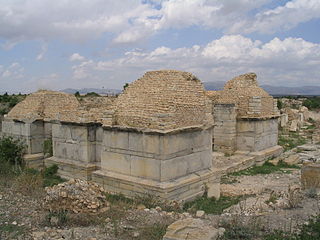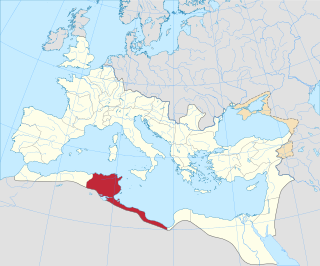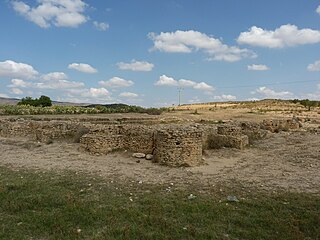
Thagamuta was a Roman–Berber city in the province of Byzacena. The location of the town is not definitively known, but it was on the plain of Guemouda in modern Tunisia.

The Roman Empire was the post-Roman Republic period of the ancient Roman civilization. It had a government headed by emperors and large territorial holdings around the Mediterranean Sea in Europe, North Africa, and West Asia. From the constitutional reforms of Augustus to the military anarchy of the third century, the Empire was a principate ruled from the city of Rome. The Roman Empire was then divided between a Western Roman Empire, based in Milan and later Ravenna, and an Eastern Roman Empire, based in Nicomedia and later Constantinople, and it was ruled by multiple emperors.

Berbers, or Amazighs are an ethnic group of several nations indigenous to North Africa.

In the history of Rome, the Latin term civitas, according to Cicero in the time of the late Roman Republic, was the social body of the cives, or citizens, united by law. It is the law that binds them together, giving them responsibilities (munera) on the one hand and rights of citizenship on the other. The agreement (concilium) has a life of its own, creating a res publica or "public entity", into which individuals are born or accepted, and from which they die or are ejected. The civitas is not just the collective body of all the citizens, it is the contract binding them all together, because each of them is a civis.
Thagamuta was also the seat of an ancient bishopric. [1] [2] There are three known (ancient) bishops of this Catholic diocese.
A bishop is an ordained, consecrated, or appointed member of the Christian clergy who is generally entrusted with a position of authority and oversight.

The word diocese is derived from the Greek term dioikesis (διοίκησις) meaning "administration". Today, when used in an ecclesiastical sense, it refers to the ecclesiastical district under the jurisdiction of a bishop.
- Lupiano who participated at the Council of Carthage (397).
- Then at the Council of Carthage (411) the Catholic bishop Milico attended. There appears to have been no Donatist bishop at this time.
- In 484 Restitutus attended the synod called in Carthage by the Vandal king Huneric, after which Restitutus was exiled.
Donatism was a schism in the Church of Carthage from the fourth to the sixth centuries AD. Donatists argued that Christian clergy must be faultless for their ministry to be effective and their prayers and sacraments to be valid. Donatism had its roots in the long-established Christian community of the Roman Africa province in the persecutions of Christians under Diocletian. Named after the Berber Christian bishop Donatus Magnus, Donatism flourished during the fourth and fifth centuries.
Huneric or Hunneric or Honeric was King of the Vandal Kingdom (477–484) and the oldest son of Genseric. He abandoned the imperial politics of his father and concentrated mainly on internal affairs. He was married to Eudocia, daughter of western Roman Emperor Valentinian III (419–455) and Licinia Eudoxia. The couple had one child, a son named Hilderic.
Today the bishopric survives as a titular bishopric and the current bishop is Jeffrey Robert Haines, of Archdiocese of Milwaukee. [3] [4] He replaced Júlio Endi Akamine in 2017.
A titular bishop in various churches is a bishop who is not in charge of a diocese. By definition, a bishop is an "overseer" of a community of the faithful, so when a priest is ordained a bishop, the tradition of the Roman Catholic and Orthodox churches is that he be ordained for a specific place. There are more bishops than there are functioning dioceses. Therefore, a priest appointed not to head a diocese as its diocesan bishop but to be an auxiliary bishop, a papal diplomat, or an official of the Roman Curia is appointed to a titular see.

Jeffrey Robert Haines is an American prelate of the Roman Catholic Church who currently serves as Auxiliary Bishop of the Archdiocese of Milwaukee, Wisconsin since 2017. He also currently serves as Rector of the Cathedral of St. John the Evangelist.

The Archdiocese of Milwaukee is a Roman Catholic archdiocese headquartered in Milwaukee, Wisconsin in the United States. It encompasses the City of Milwaukee, as well as the counties of Dodge, Fond du Lac, Kenosha, Milwaukee, Ozaukee, Racine, Sheboygan, Walworth, Washington and Waukesha, all located in Wisconsin. The Archdiocese of Milwaukee is the metropolitan see of the ecclesiastical province of Milwaukee, which includes the suffragan dioceses of Green Bay, La Crosse, Madison, and Superior. As of 2018, Jerome Edward Listecki is the Archbishop of Milwaukee.





